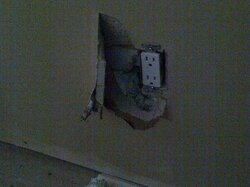In my case, I'm told the strike travelled in through the neutral - not much you can do about that I don't think.
If true, then major human safety threats remain. For that to be true, then an NEC required earth ground must be missing. Relevant concepts were originally taught in elementary school science. And often get forgotten.
Lightning seeks earth ground. A path for a 20,000 amp electric surge is via a wooden church steeple destructively to earth. Wood is not a good conductor. So 20,000 amps creates a high voltage. 20,000 amps times a high voltage is high energy. Church steeple damaged.
Franklin installed a lightning rod. Now 20,000 amps is via a wire to an earthing electrode. High current creates near zero voltage. 20,000 amps times a near zero voltage is near zero energy. Nothing damaged.
Lightning seeks earth ground. A lightning strike to utility wires far down the street is a direct strike, incoming to every household appliance, destructively to earth. Appliances are not a good conductor. So lightning creates a high voltage. Lightning current times a high voltage is high energy. Appliances damaged.
For over 100 years, facilities that cannot have damage installed superior earthing connected low impedance (ie 'less than 10 feet') via one 'whole house' protector. Then high current creates near zero voltage. 20,000 amps times a near zero voltage is near zero energy. No appliance is damaged.
In your case, electricity was incoming on AC mains hot (black) wire. A best connection to earth was that picture causing wall and styrofoam damage. You did not earth that surge at the service entrance via a 'whole house' protector. So lightning was inside hunting for earth destructively. This time it found a best connection via that AC receptacle. Next time, what appliance or human will be a destructive connection to earth?
All cable and satellite cables are required (NEC, FCC, etc) to have protection - a low impedance (ie 'less than 10 feet') connection from each cable to a common (single point) earth ground. Telephone wires cannot connect directly. So each telco installs a 'whole house' protector - for free. All incoming wires have best protection IF you have properly installed and routinely inspected what only you are responsible for - the earth ground. And IF that connection to earth is that short.
AC electric wires connect a lightning strike far down the street directly into every receptacle and appliance. Because you obviously have not earthed a 'whole house' protector. Is every appliance damaged? Of course not. Lightning hunted for and found a best outgoing path to earth - the receptacle. Again, from elementary school science. To have damage means electricity must have both an incoming path and an outgoing path to earth. Every incoming wire must first connect to single point earth ground before entering. So that an outgoing path to earth is never inside the building.
An earth ground connection either hardwired directly (cable TV, satellite dish) or via a 'whole house' protector (telephone, AC electric). Otherwise everything inside a house remains at risk. Protection from direct strikes is routine. A lightning rod earthed to protect the building. All incoming utility wires earthed at the service entrance to protect contents of that building.



 Pain in the butt to replace things but pretty minimal in the scheme of things. Forces of nature can be pretty awesome to behold...
Pain in the butt to replace things but pretty minimal in the scheme of things. Forces of nature can be pretty awesome to behold...